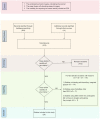Decoding Covert Speech From EEG-A Comprehensive Review
- PMID: 33994922
- PMCID: PMC8116487
- DOI: 10.3389/fnins.2021.642251
Decoding Covert Speech From EEG-A Comprehensive Review
Abstract
Over the past decade, many researchers have come up with different implementations of systems for decoding covert or imagined speech from EEG (electroencephalogram). They differ from each other in several aspects, from data acquisition to machine learning algorithms, due to which, a comparison between different implementations is often difficult. This review article puts together all the relevant works published in the last decade on decoding imagined speech from EEG into a single framework. Every important aspect of designing such a system, such as selection of words to be imagined, number of electrodes to be recorded, temporal and spatial filtering, feature extraction and classifier are reviewed. This helps a researcher to compare the relative merits and demerits of the different approaches and choose the one that is most optimal. Speech being the most natural form of communication which human beings acquire even without formal education, imagined speech is an ideal choice of prompt for evoking brain activity patterns for a BCI (brain-computer interface) system, although the research on developing real-time (online) speech imagery based BCI systems is still in its infancy. Covert speech based BCI can help people with disabilities to improve their quality of life. It can also be used for covert communication in environments that do not support vocal communication. This paper also discusses some future directions, which will aid the deployment of speech imagery based BCI for practical applications, rather than only for laboratory experiments.
Keywords: brain-computer interfaces (BCI); covert speech; electroencephalogram (EEG); imagined speech; inner speech; neurorehabilitation; speech imagery.
Copyright © 2021 Panachakel and Ramakrishnan.
Conflict of interest statement
The authors declare that the research was conducted in the absence of any commercial or financial relationships that could be construed as a potential conflict of interest.
Figures









Similar articles
-
The Role of Artificial Intelligence in Decoding Speech from EEG Signals: A Scoping Review.Sensors (Basel). 2022 Sep 15;22(18):6975. doi: 10.3390/s22186975. Sensors (Basel). 2022. PMID: 36146323 Free PMC article.
-
A State-of-the-Art Review of EEG-Based Imagined Speech Decoding.Front Hum Neurosci. 2022 Apr 26;16:867281. doi: 10.3389/fnhum.2022.867281. eCollection 2022. Front Hum Neurosci. 2022. PMID: 35558735 Free PMC article. Review.
-
Decoding imagined speech from EEG signals using hybrid-scale spatial-temporal dilated convolution network.J Neural Eng. 2021 Aug 11;18(4). doi: 10.1088/1741-2552/ac13c0. J Neural Eng. 2021. PMID: 34256357
-
Adaptive LDA Classifier Enhances Real-Time Control of an EEG Brain-Computer Interface for Decoding Imagined Syllables.Brain Sci. 2024 Feb 21;14(3):196. doi: 10.3390/brainsci14030196. Brain Sci. 2024. PMID: 38539585 Free PMC article.
-
Decoding covert speech for intuitive control of brain-computer interfaces based on single-trial EEG: a feasibility study.IEEE Int Conf Rehabil Robot. 2019 Jun;2019:689-693. doi: 10.1109/ICORR.2019.8779499. IEEE Int Conf Rehabil Robot. 2019. PMID: 31374711
Cited by
-
Rethinking the Methods and Algorithms for Inner Speech Decoding and Making Them Reproducible.NeuroSci. 2022 Apr 19;3(2):226-244. doi: 10.3390/neurosci3020017. eCollection 2022 Jun. NeuroSci. 2022. PMID: 39483370 Free PMC article.
-
Evaluation of an English language phoneme-based imagined speech brain computer interface with low-cost electroencephalography.Front Neuroinform. 2023 Dec 18;17:1306277. doi: 10.3389/fninf.2023.1306277. eCollection 2023. Front Neuroinform. 2023. PMID: 38192730 Free PMC article.
-
[Study on speech imagery electroencephalography decoding of Chinese words based on the CAM-Net model].Sheng Wu Yi Xue Gong Cheng Xue Za Zhi. 2025 Jun 25;42(3):473-479. doi: 10.7507/1001-5515.202503048. Sheng Wu Yi Xue Gong Cheng Xue Za Zhi. 2025. PMID: 40566768 Free PMC article. Chinese.
-
Multiclass classification of imagined speech EEG using noise-assisted multivariate empirical mode decomposition and multireceptive field convolutional neural network.Front Hum Neurosci. 2023 Aug 10;17:1186594. doi: 10.3389/fnhum.2023.1186594. eCollection 2023. Front Hum Neurosci. 2023. PMID: 37645689 Free PMC article.
-
The Role of Artificial Intelligence in Decoding Speech from EEG Signals: A Scoping Review.Sensors (Basel). 2022 Sep 15;22(18):6975. doi: 10.3390/s22186975. Sensors (Basel). 2022. PMID: 36146323 Free PMC article.
References
-
- Abdulkader S. N., Atia A., Mostafa M.-S. M. (2015). Brain computer interfacing: applications and challenges. Egypt. Inform. J. 16, 213–230. 10.1016/j.eij.2015.06.002 - DOI
-
- Agarap A. F. (2018). Deep learning using rectified linear units (ReLU). arXiv preprint arXiv:1803.08375.
Publication types
LinkOut - more resources
Full Text Sources
Other Literature Sources
Miscellaneous

